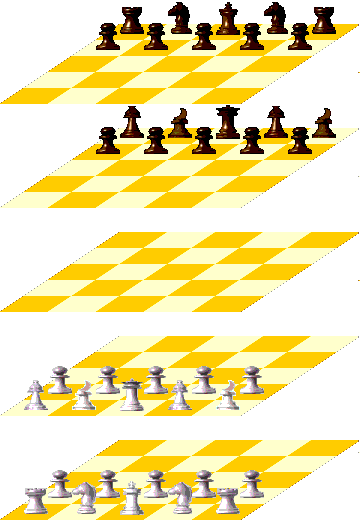Raumschach
Raumschach (German for Space Chess) is one of the first three-dimensional chess variants and the first to survive until present times. It was invented by Herr Doktor Ferdinand Maack in 1907. Maack first experimented with an 8x8x8 array but later determined that a 5x5x5 array yields a nicer game. Maack founded a Raumschach club in Hamburg in 1919, which remained active until the Second World War.
Board
The 3-D board is actually a cube sliced into 4 equal spaces across each of its three major coordinal planes. This sectioning yields a 125-cell playing volume. Traditionally, the cell floors (or squares) are alternately colored black and white, although a four-color scheme helps one to visualize the moves of the Unicorn (see below), just as a two-color scheme helps one to visualize the moves of the orthochess Bishop.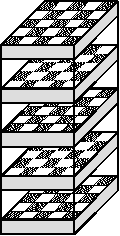
Notation
Various types of algebraic notation have been used for recording Raumschach games. We will employ the following notational system in this article:A, B, C, D, and E denote the 5 vertical levels, with A being White's home level and E being Black's. Within each level, ordinary algebraic notation applies. Thus, viewed from the "front" (White's side), the front, left, bottom "square" (or cell) is Aa1, whereas the diagonally opposite square is Ee5.
The Pieces
The pieces in the three-dimensional game are:
| Symbol | Graphic | Piece |
|---|---|---|
| K / k | King | |
| Q / q | Queen | |
| R / r | Rook | |
| B / b | Bishop | |
| N / n | Knight (German: Springer) | |
| U / u | Unicorn (German: Einhorn) | |
| P / p | Pawn |
The moves of the Rook, Bishop and Knight are the same as in orthochess, although extended through extra dimensions.
Remember that any plane which intersects a particular space can be thought of as 2-D chess board. For example, the set of cells at the front of the board, xy1 (where x and y are arbitrary) forms a two-dimensional board whereon the 2-D rules apply. The rules for other cases are similar.
In the following two diagrams, the two additional planes of movement are shown for a piece at position c4 (any level).
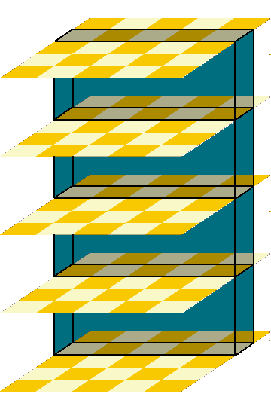 |
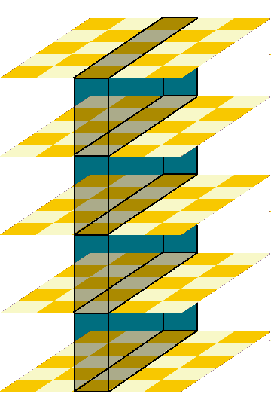 |
Detailed description of each piece's moves:
Rook
The Rook may move as far as possible along any file, rank or column, until blocked by another piece. The Rook can be visualized as moving through the faces of the cells.A Rook positioned at Cc3 can move to:
| Ccx | (i.e. along a file) |
| Cx3 | (i.e. along a rank) |
| Xc3 | vertically, along a column |
Bishop
The Bishop moves as in orthochess along any coordinal plane. The Bishop can be visualized as moving through the edges of the cells.A bishop positioned at Dc4 on an empty board can move to:
| Da2, Db3, Dd5, De2, Dd3, Db5 exactly as in 2D chess | ||
Eb4, Ed4, Cb4, cd4, Ba4, Be4 in the front plane:
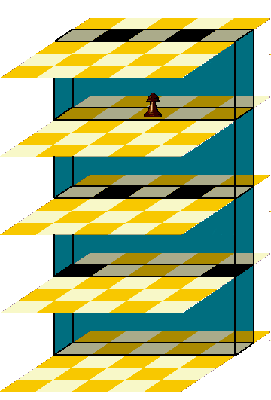
|
Ec3, Ec5, Cc3, Cc5, Bc2, Ac1 in the side plane:
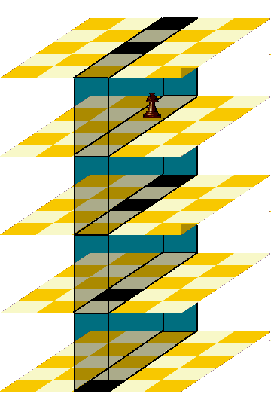
|
|
Unicorn
The Unicorn moves through the 3-D diagonals. The Unicorn can be visualized as moving through the corners of the cells.A Unicorn placed at Cc3 on an empty board can move to Dd4, Ee5, Bb2, Aa1, Db2, Ea1, Bd4, Ae5, Ee1, Dd2, Bb4, Aa5, Ea5, Db4, Bd2 and Ae1.
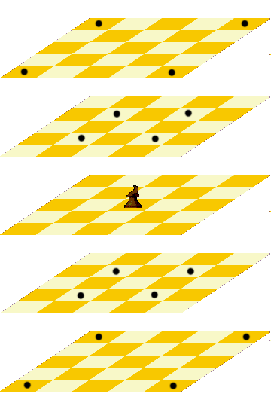
Queen
The Queen has the combined moves of Rook, Bishop and Unicorn. The Queen can be visualized as moving serially through (1) the faces of the cells, (2) the edges of the cells, or (3) the corners of the cells.King
The King moves as the Queen but only one step per turn.Knight
The Knight moves as in orthochess: one cell orthogonally followed by one cell outward-diagonally, always in the same coordinate plane. The Knight can be visualized as taking one step through the face of a cell followed by one step the edge of a cell. It may never step through the corner of a cell..Note that the 3-D Knight is much more powerful than its 2-D counterpart. A 2-D Knight requires four moves to go from Aa1 to Ac3. A 3-D Knight requires only two: Aa1 - Bc1 - Ac3. Check it out!--It works.
Pawn
The Pawn's move is a little more complicated than in 2-D chess. The following chart explains the move options of each side's Pawns:| Passive Moves | Capture Moves | |
|---|---|---|
| White Pawn | straight-forward or straight-upward | diagonally forward or diagonally forward-upward |
| Black Pawn | straight-forward or straight-downward | diagonally forward or diagonally forward-downward |
(Please understand that the forward direction is relative to the initial placement of one's pieces, whereas the upward and downward directions are absolute.)
According to the above chart, a White Pawn at Ac2 can move to Ac3 (as in 2-D chess) or Bc2 and capture at Ab3, Ad3 (as in 2-D chess), or at Bb2, Bd2, and (according to some) at Bc3, although I personally do not like this variant. [Please note that Anthony Dickens supports the Bc3 move in A Guide to Fairy Chess.]
Pawns promote on the last (or fifth) rank, which is the far side of level A and level B for White, and the far side of level D and level E for Black. There is no 2-step initial move in Raumschach, thus no en passant capture.
Initial Layout
The Raumschach array is somewhat similar to that of orthochess.
 Level E
Level E
Black: |
Level E: +---+---+---+---+---+ | r | n | k | n | r | 5 +---+---+---+---+---+ | p | p | p | p | p | 4 +---+---+---+---+---+ | | | | | | 3 +---+---+---+---+---+ | | | | | | 2 +---+---+---+---+---+ | | | | | | 1 +---+---+---+---+---+ a b c d e |
|
Black: |
Level D: +---+---+---+---+---+ | b | u | q | b | u | 5 +---+---+---+---+---+ | p | p | p | p | p | 4 +---+---+---+---+---+ | | | | | | 3 +---+---+---+---+---+ | | | | | | 2 +---+---+---+---+---+ | | | | | | 1 +---+---+---+---+---+ a b c d e |
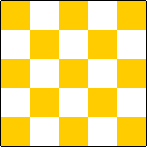 Level C
Level C
Empty at startup. |
Level C: +---+---+---+---+---+ | | | | | | 5 +---+---+---+---+---+ | | | | | | 4 +---+---+---+---+---+ | | | | | | 3 +---+---+---+---+---+ | | | | | | 2 +---+---+---+---+---+ | | | | | | 1 +---+---+---+---+---+ a b c d e |
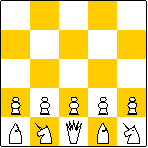 Level B
Level B
White: |
Level B: +---+---+---+---+---+ | | | | | | 5 +---+---+---+---+---+ | | | | | | 4 +---+---+---+---+---+ | | | | | | 3 +---+---+---+---+---+ | P | P | P | P | P | 2 +---+---+---+---+---+ | B | U | Q | B | U | 1 +---+---+---+---+---+ a b c d e |
|
White: |
Level A: +---+---+---+---+---+ | | | | | | 5 +---+---+---+---+---+ | | | | | | 4 +---+---+---+---+---+ | | | | | | 3 +---+---+---+---+---+ | P | P | P | P | P | 2 +---+---+---+---+---+ | R | N | K | N | R | 1 +---+---+---+---+---+ a b c d e |
3D Perspective Rendering
The diagram below shows the initial layout of the board. It is taken from the Zillions of Games implementation of this game (see below).Zillions of Games
Robert Price has programmed Raumschach for Zillions of Games. You can download his program here.
Notes on practical construction
A practical Raumschach board (or cube) can be constructed from 5 plexiglas sheets, each displaying a 5x5 grid. The coloring alternates: Board A has black in the corner, Board B has white in the corner, etc. The dimensions of the human hand require that the squares be about 2 inches (5 cm) wide and the board separation be between 5 and 7 inches. The exact separation will depend on the size of the pieces and the care with which one is willing to move the pieces. The "black" squares should be translucent in order to facilitate sighting through the diagonals.Bibliography
Modern books
A Guide to
Fairy Chess, Anthony Dickins, Dover, pp 16-18
Classics of Fairy Chess,
T. R. Dawson, Dover.
English language periodicals
T.R. Dawson, Chess Amateur "Half Hours" column, July 1926 to December (volumes XX and XXI).
This source contains, among other things, a complete game between experienced players.
In The Fairy Chess Review, Vol. 5, No. 5, April, 1943, pp. 40, T. R. Dawson briefly describes this game under the name of Space Chess.
Fairy Chess Review, December, 1945.
Other material
Das Schachraumspiel: Dreidimensionales Schachspiel'
Spielregeln zum
Raumschach
Raumschach: Einfuehrung in die Spielpraxis
all by Dr Maack of
Hamburg, early part of this century.
Deutsche Schachzeitung 1878
- October 11, 1990, Bruce Balden, posted the rules of Raumschach on rec.games.chess.
- Hans Bodlaender edited that text, and added pictures; also adding some information taken from the Encyclopedia of Chess Variants by David Pritchard.
- Thanks to Alfred Pfeiffer for noting an error.
- Thanks to Robert Price for implementing the Zillions version of this game.
- September 26, 2001: Thanks to John William Brown for editing the text of this page.
A version with boards in ASCII is also available.
WWW page created: 1995. Last modified: October 8, 2002.

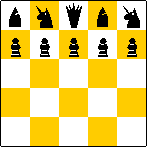 Level D
Level D
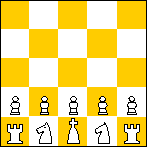 Level A
Level A
